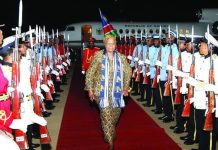Africa-Press – Namibia. NAMIBIA IS A small, vulnerable economy with an openness index of close to 80%. It relies heavily on rain-fed agriculture and imports more than 60% of its electricity needs.
Yet, this unsuspecting territory of less than 3 million people is endowed with enough renewable energy potential to become a regional powerhouse that could significantly reduce sub-Saharan Africa’s reliance on carbon-based fuels.
Often, a key constraint to deploying large-scale solar and wind assets is the limited amount of land given a country’s population density.When looking at land availability, Namibia is uniquely gifted. Given its territory of more than 824 000km2, population of just 2,5 million people, and annual energy consumption of two and a half terawatt-hours, Namibia posts an energy-demand density score of three megawatt-hours per square kilometre every year.
Land availability, therefore,is not a constraint to developing large-scale renewable energy systems. And this is before considering that many parts of Namibia boast solar and onshore wind capacity factors in excess of 30% and 50%, respectively. Our offshore wind resource, measured by Bloomberg New Energy Finance, exhibits raw capacity factors in excess of 60% and remains completely untapped.
Reducing carbon emissions Renewable energy prices have plummeted over the past decade.Prices at global and regional auctions for renewable energy installations fell by more than 60% and 80% for wind and solar installations, respectively.
At the same time, the world’s ambition to de-carbonise its industrial engines of growth, given their insatiable appetite for carbon-emitting fuels, is greater than ever. World leaders, both private and public, have never been more united about a contentious topic as they are today.
This newfound commitment to lowering carbon emissions has manifested in a flurry of policy interventions and financial pledges. The number of countries announcing carbon-neutral targets between 2050 and 2060 is ever climbing, while the amount of sustainable climate financing is reaching record levels.
The first six months of 2021 saw more climate funding raised than all of 2020. And the latest US$1 billion of sustainable financing was raised in just eight months, whereas the first US$2 billion took three years. In this global context, Namibia considers its contribution to the fight against climate change a ‘strategic bet’.
President Hage Geingob and the Namibian government understand that Namibia has a once-in-a-generation opportunity to significantly reduce its emissions – and that of its neighbours – by leveraging its natural endowments to attract much-needed foreign direct investment. Southern Corridor Development Initiative
It was in this spirit that the Southern Corridor Development Initiative (SCDI) in Namibia’s //Kharas region was conceptualised. The SCDI is envisioned to include a portfolio of complementary infrastructure projects in the //Kharas region, which if effectively conceptualised and delivered could have a transformative impact on the Namibian economy. The portfolio includes renewable energy plants, green hydrogen ammonia assets, rail and port concessions, nearby mining hubs and agricultural assets.
The //Kharas region is in Namibia’s southernmost region. It has the lowest population density in the country but has the greatest renewable-energy potential. Strategically situated on the shores of the Atlantic Ocean, the region offers Namibia the perfect opportunity to share its resources. Its Lüderitz port is well-positioned to act as a conduit to deliver green hydrogen and ammonia to the world. Namibia’s port operator, the Namibian Ports Authority (Namport), recently signed a memorandum of understanding (MOU) with Europe’s largest port operator, the Port of Rotterdam, to build the necessary infrastructure to transport these clean fuels to Europe.
By delivering on the vision of the SCDI, Namibia is meaningfully contributing to a just and equitable energy transition in southern Africa and beyond. Strategic partnerships
Since the launch of our Harambee Prosperity Plan II in March 2021, Namibia has signed a joint communique of intent with Germany, an MOU with Rotterdam, and is on course to announce similar partnerships with our Belgian and Dutch counterparts at the COP26 summit currently underway in Glasgow, Scotland.
We recently hosted a continent-first energy roundtable with the World Economic Forum where we issued a global invitation for international collaboration to build gigawatt-scale electrolyser units in the //Kharas region.
This invitation culminated in nine multi-billion-dollar proposals from six global, regional, and local developers, which at the time of writing this article, we have just completed reviewing.
The proposals are rich, complex, and diverse, and we are analysing them from a variety of approaches with input from the United States’ Scaling Up Renewable Energy sure programme and the European Union’s Global Technical Assistance Facility on Sustainable Energy.
Colorado’s National Renewable Energy Lab in the US has also provided an intricate review of the financial and technical models submitted, while European energy experts provided holistic and well-rounded qualitative analyses.
–World Economic Forum
* James Mnyupe is the presidential economic advisor and hydrogen commissioner for the Namibian government. The views expressed in this article are those of the author alone and not the World Economic Forum.
For More News And Analysis About Namibia Follow Africa-Press






